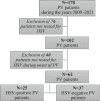Relationship Between Pemphigus Vulgaris Severity and PCR-positive Herpes Simplex Virus
- PMID: 35393625
- PMCID: PMC9631263
- DOI: 10.2340/actadv.v102.917
Relationship Between Pemphigus Vulgaris Severity and PCR-positive Herpes Simplex Virus
Abstract
Pemphigus vulgaris is a rare autoimmune skin disease. Although herpes simplex virus has been associated with autoimmune diseases, evidence regarding its association with pemphigus vulgaris exacerbations is scarce. This retrospective cohort study aimed to characterize the epidemiological and clinical features of patients with pemphigus vulgaris who were herpes simplex-positive, compared with those who were herpes simplex-negative, during disease onset. Of 62 patients with pemphigus vulgaris who underwent PCR testing for herpes simplex virus, 25 (40.3%) were positive, with a mean age of 56.1 ± 15.5 years; 35.5% were male. The herpes-positive group had significantly elevated levels of C-reactive protein, Pemphigus Disease Activity Index score, and shorter time to relapse. The time to remission, number of exacerbations per year, and remission status were non-significantly elevated in the herpes-positive group. Thus, routine testing lesions from patients with pemphigus for herpes simplex virus should be performed. If positive, antiviral treatment should be initiated; and preventive antiviral treatment should be considered in severe cases.
Conflict of interest statement
Figures



References
-
- Kridin K. Pemphigus group: overview, epidemiology, mortality, and comorbidities. Immunol Res 2018; 66: 255–270. - PubMed
-
- Kayani M, Aslam AM. Bullous pemphigoid and pemphigus vulgaris. BMJ 2017; 357. - PubMed
-
- Bystryn JC, Rudolph JL. Pemphigus. Lancet 2005; 366: 61–73. - PubMed
-
- Lever WF, Hashimoto K. The etiology and treatment of pemphigus and pemphigoid. J Invest Dermatol 1969; 53: 373–389. - PubMed
MeSH terms
Substances
LinkOut - more resources
Full Text Sources
Medical
Research Materials

